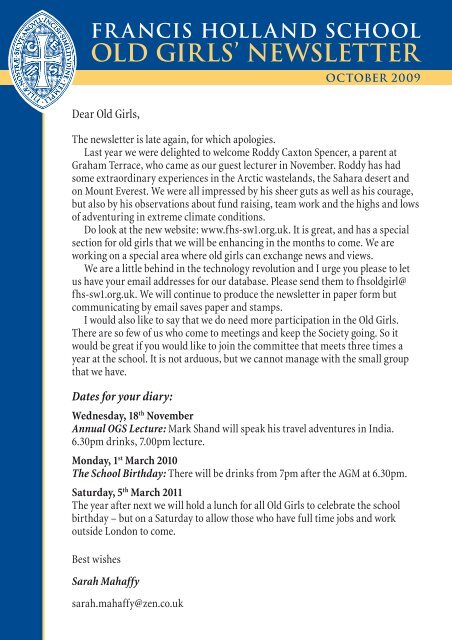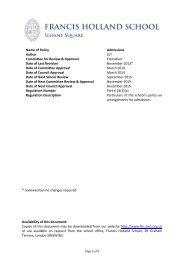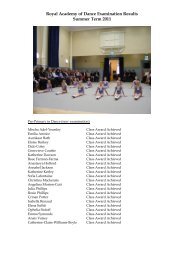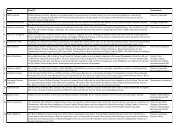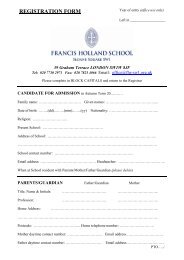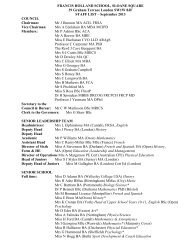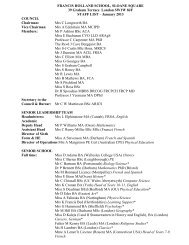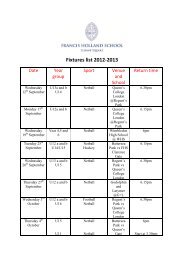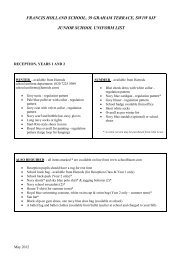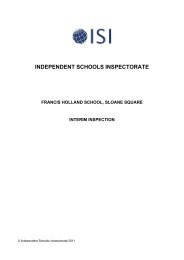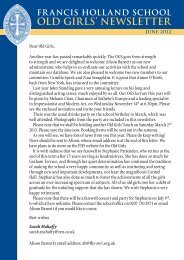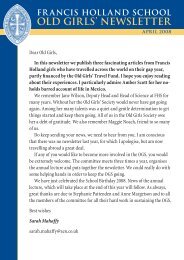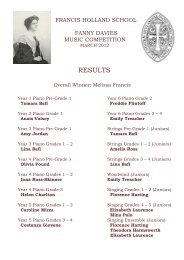Newsletter 2009 - Francis Holland School
Newsletter 2009 - Francis Holland School
Newsletter 2009 - Francis Holland School
You also want an ePaper? Increase the reach of your titles
YUMPU automatically turns print PDFs into web optimized ePapers that Google loves.
fr ancis <strong>Holland</strong> <strong>School</strong>OLD GIRLS’ NEWSLETTERoctober <strong>2009</strong>Dear Old Girls,The newsletter is late again, for which apologies.Last year we were delighted to welcome Roddy Caxton Spencer, a parent atGraham Terrace, who came as our guest lecturer in November. Roddy has hadsome extraordinary experiences in the Arctic wastelands, the Sahara desert andon Mount Everest. We were all impressed by his sheer guts as well as his courage,but also by his observations about fund raising, team work and the highs and lowsof adventuring in extreme climate conditions.Do look at the new website: www.fhs-sw1.org.uk. It is great, and has a specialsection for old girls that we will be enhancing in the months to come. We areworking on a special area where old girls can exchange news and views.We are a little behind in the technology revolution and I urge you please to letus have your email addresses for our database. Please send them to fhsoldgirl@fhs-sw1.org.uk. We will continue to produce the newsletter in paper form butcommunicating by email saves paper and stamps.I would also like to say that we do need more participation in the Old Girls.There are so few of us who come to meetings and keep the Society going. So itwould be great if you would like to join the committee that meets three times ayear at the school. It is not arduous, but we cannot manage with the small groupthat we have.Dates for your diary:Wednesday, 18 th NovemberAnnual OGS Lecture: Mark Shand will speak his travel adventures in India.6.30pm drinks, 7.00pm lecture.Monday, 1 st March 2010The <strong>School</strong> Birthday: There will be drinks from 7pm after the AGM at 6.30pm.Saturday, 5 th March 2011The year after next we will hold a lunch for all Old Girls to celebrate the schoolbirthday – but on a Saturday to allow those who have full time jobs and workoutside London to come.Best wishesSarah Mahaffysarah.mahaffy@zen.co.uk
Letter from the HeadmistressGenerations of <strong>Francis</strong> <strong>Holland</strong> Girls will, I am sure, remember walking along BourneStreet and wondering about the Grosvenor Club, right next door to the school buildings.What happened there? It always seems so quiet; does anyone ever go there? What a pitythe school cannot use this large building, named Carmel Hall. And indeed one cannotmiss the large building when walking across the playground. The Year 2008/09 willsurely go down in the school’s history as a momentous year – the year when the schoolacquired the Grosvenor Club building and began to plan how best it could be put to usefor the benefit of all pupils.During the early part of the year detailed plans were drawn up and approved bythe Governors and the local Council and work began in June <strong>2009</strong>. By the beginningof the new school year in September 2010 the building works should be complete. Theredesigned Carmel Hall will house three teaching rooms, various offices and storagespaces, an instrument store, ten music practice rooms and another medium sized hallspace suitable for music and drama.The project has also provided an opportunity for expansion of the school hall and thedining room, both of which are much needed. For some years it has not been possiblefor Juniors and Seniors to join together at assembly owing to the increased numbersin the senior school and the dining room has become very cramped. The hall will belengthened, which has necessitated the temporary removal of the beautiful stained glasswindows. They will be reinstated, in a different position, at the end of the work. Thedining room will also be longer and more spacious.One of the other main events of the year has been the development and launch of thenew school web site. Please do take a look; it is packed with useful information and thenews section is always kept well up to date with short reports of all the events that havebeen taking place. (www.fhs-sw1.org.uk)A quick read of the newsletter this year will demonstrate magnificently that the FHSOld Girls’ Society is very much alive. The travel fund clearly provides much neededsupport for the girls who choose to take on adventurous journeys and tasks in gap yearsand the annual lecture is one of the highlights of the school year. I hope as many aspossible of you will be able to come to this year’s lecture given by Mark Shand.In her introductory letter, Sarah Mahaffy has drawn to your attention the change ofplan for celebrating the school birthday for 2011. The evening parties every other year arealways popular but some people find an evening event in London not suitable, hence thisnew idea. Please make a note of the date in your diary now!As ever, Old Girls are always very welcome to come to any of the school events andthey are all now published on the web site. A quick call, or email, to the school office firstwould help with numbers. (office@fhs-sw1.org.uk)Stephanie PattendenHeadmistress
A trip to RussiaGeorgia ForthThe day before I set off for Russia, London had been forced to a standstill by what the pressdescribed as the greatest snowfall in 18 years, about 20cm. There had been talk of our planenot taking off. How did Russia cope? When I arrived in Moscow, however, it was drizzlingreassuringly in that horrible, muggy way that I had thought was only possible back at home.By the time we reached the motorway this had evolved into what I’m sure was a full scaleblizzard. It felt fitting. What was I, who barely spoke rudimentary Russian and had next tono real teaching experience, doing sending myself into the depths of rural Russia to teachEnglish to “traumatized” orphans? Meeting the other volunteers, two super-confident thirdyear language students and a middle aged Australian lady who had spent the previous fouryears teaching Aboriginal children in the outback, did little to allay the growing feeling thatI was way out of my depth.About five hours into our journey the car began to swerve dangerously. Our driver, Vlad,immediately pulled over by a snow drift, opened the minibus door, and dived straight intoit. He slapped his face a few times then, satisfied that he was fully awake, he dusted himselfoff, jumped back in and continued driving. Later, when we stopped in a service station Isomewhat smugly discovered that not only could I make my request for a toilet (Russian fortoilet: tooaliet…) understood by the “babushka” working there, but that I could translateevery word of her surprisingly lengthy directions. Maybe those beginner evening classeshad paid off after all!Gradually, the blizzard died down, night fell and the road became an endless successionof tall trees lit by the (unheated) minibus’ headlamps. At last, we came to a stop in what atfirst appeared to be the middle of nowhere. I could vaguely make out a fairytale cottage inthe distance. We had arrived.Over the next few days my sense of unreality increased and we learned more aboutthis place we had come to. Although it is a home for orphans, this place was definitelynot a Russian Orphanage. According to the organisation, there are one million orphansin Russia. Many of them are “social orphans”, generally the children of alcoholic parentswho can no longer cope. The traditional impersonal, almost Dickensian, orphanagesystem is reportedly ill-equipped for the needs of these vulnerable children. Kitezhoffers an alternative, where children are fostered and raised in a family environment,in a therapeutic community specifically geared towards their needs. After the initial“honeymoon period” it can reportedly take around two years challenging “testing” of thenew family’s commitment before newly fostered children fully settle in and truly believethat they have found a permanent home.Before I left for Russia, I had been worried that the lifestyle could come as something ofa shock. Us pampered westerners, warned the otherwise accurate and extensive VolunteerHandbook, were ill equipped for the hardships of every day life in rural Russia, a longdrive from “civilization”. Although this was true on some levels, I found the standard ofliving little different to what I was used to, even though some of the Russians seemed not tobelieve this, asking questions such as “do you have mops in England?”
Indeed, compared to other people’s Gap Year experiences of living in mud huts with norunning water and limited food, I lived in luxury. The thing I found most challenging wasthe almost complete lack of privacy. Most space was shared and in such a small community(less than 50 people) everyone knew everyone else’s business.Unexpectedly, I also found the near lack of fruit and sweet things difficult. We hadalmost no sweet desserts and our fruit was half an apple once every two weeks if we werelucky- I nearly bankrupted myself when I finally went to an indoor fruit and market inKaluga, the nearest (two hours drive away) city. Before I went to Russia I thought of myselfas more of a “savory” person, someone who was more or less indifferent to chocolateand sweets. After a week I would’ve sold my soul for a nearby corner shop. The food waswholesome, however, and often eccentric, with delicacies such as pasta with hot milk forbreakfast (actually quite delicious), and thanks to the cook’s amazing borsch I developeda great love of beetroot. I could not, however, like the dreaded gretchka (buckwheat)which was served with every other meal and never learned to stomach the liver, which Iunfailingly forgot the Russian for every time it was served and so ended up with on myplate and then had to think of increasingly ingenious ways of disposing of it diplomatically(wasting food was strictly “nilzya” [not allowed]).I fortunately got on well with the other volunteers and we quickly fell into the routineof Morning Exercises followed by first breakfast (like most meals, eaten communally ina large dining room) followed by morning lessons/ washing up, then second breakfast(hobbits!) then more lessons/ washing up and then lunch at two o’clock. Then there was“Community Work Hour”, an ingenious way to get most of the chores in the communitydone with everyone pitching in and taking ownership. This timetable was followed everyday except Sunday, which meant that days had a habit of rolling into one another, making itvery easy to lose track of time.Yet it was never monotonous. The classes were small and the children bright andgenerally enthusiastic. Lessons followed a set curriculum to provide continuity andstructure, given that for most classes the English teachers changed every three months,therefore, the main challenge was to make them interesting without departing too muchfrom the text book. The timetable for each day’s lessons would be drawn up the night beforeand posted in the dining room after dinner, so I would often not know which lessons Ishould be planning until the night before.Plans were made and then changed suddenly, seemingly on a whim. They appearedat times to be deliberately disorganized, as if to make sure life never became too dulland predictable. On one memorable occasion the Council kindly organized a trip for usvolunteers to a famous war museum that we had been told was a “must see” on… RussianEaster Sunday. So obviously, when we got there the museum was closed (when we toldthe Kitezhans this on our return our surprise was met with bemusement: “what did youexpect?? It’s Easter Sunday!”) Despite this, we ended up having lots of fun with the giantSoviet mosaic and tank outside the museum, and were still able to visit the famous crater,formally the highest point in Kaluga region, where the Russians literally “undermined” theGermans during WWII.In the evenings and days off, people made their own entertainment, with interestinghobbies such as authentic sword fighting and outdoor sports and games. The children
organised discos and performance nights and I found myself looking forward to the eveningexercise classes that were arranged several times a week, and when someone startedup ballroom dancing lessons I and the other volunteers jumped at the chance to learn,something that I never would have done at home. I also discovered the joys of Hollywoodmovies dubbed in Russian and, hilariously, pirate copies of Disney cartoons with a Russianman speaking over all the parts (songs included) in a monotone. On several occasions,a student attempted to teach us about Russian poetry by dramatically reciting someLermontov and then translating it line by line in comically eccentric “video game” English.Indeed, even the chores could be fun in the right circumstances. When I spent sometime in Orion- a smaller village, where I was the only non-native Russian speaker, mostof my assigned chores were with a student whose English was about the same level asmy Russian (apart from the most basic of tourist essentials, virtually non-existent). Weamused ourselves by teaching each other how to say what we were doing in our respectivelanguages, e.g. “I am washing a pot with a sponge”- Ya moyu kastrulyu goobkoi and “Ipainted a wall”- Ya krasila stenu.Not having previously thought of myself as an “out doorsey person”, I also was shockedto discover that one of my favourite things to do was work on the farm. As soon as the snowmelted work began on renovating an old farm that lay on the land and was now no longerin use. I enjoyed raking and “pitch forking” hay in the sun as the community dog, Boris,bounded around trying to help. After months of snow just being able to see the groundwas exciting, and seeing everyone working on the land, some even wearing headscarves,made me feel like a participant in an early Soviet-era propaganda film. In a move that wastypical of the spontaneity of the place, early morning lessons were suspended for two weeksas everyone went to work on the farm, pulling together to ensure it was ready for when thefirst animals were due to arrive in a few weeks time. But the most exciting aspect of thisby far was when the point of all that raking was finally revealed: burning off the top layer.Vast stretches of field were set dramatically alight, the flames sometimes blending with thesunset as shadows of people trying to keep the fire under control could vaguely be made outthrough the thick smoke.Me rakingand burningThe natural surroundings of the area, particularly during the “thaw”, werebreathtaking. As the season changed I began to understand the Russian affinity withnature (even city dwellers traditionally have a small “dacha” in the countryside that they
escape to at every opportunity). I willingly went on a day long trek, knee deep in glitteringslush across miles of field and forest, to build a camp fire and learn how to survive “in thewild”. When spring finally arrived, I and other volunteers began exploring the countryside,and even turned some lessons into walks.Every few weeks or so there was a Yarmarka, a sort of village fete, where the childrencould use the “currency” they earned by being good to purchase things such as school books,haircuts (one of the community members is a very skilled, “80s style” hairdresser), bakedgoods and anything else that people think might be fun to try and sell. While I was therethese included a twister game, a Tarot booth; a stall where things from the junk room of oneof the houses were exuberantly touted as wonderful treasure; and a man who charged peopleto have their picture taken with his pet snake and/ or the albino cockroaches he bred to feedit. One Yarmarka, two of us volunteers baked cakes to sell which went down very well andmeant that I could buy a much needed exercise book and some pens.Before I left, I was also able to experience a scaled down version of a huge, communitywide Role Playing Game that had become a summer tradition. Every year, children fromorphanages were invited to join in and inhabit fantastical roles for up to two weeks. This isone way in which new children are selected, as it is thought that the absorbing context ofthe game allows the true qualities and potential of a traumatised child shine through their“negative programming.”The week long Easter “Game” was based on a computer game called “Mass Effect” andus foreign volunteers were given cameo roles as baddies. Accordingly, half way through theweek I found myself in full terrorist garb standing in the middle of the forest listening to aspeech delivered from the top of a rusting oil drum by a boy wearing bizarre face paint andbunches. On the way there we had come across a real police car and had had to take off ourmasks and hide our very realistic replica guns. As I listened uncomprehendingly to “ourleader’s” charismatic tirade, responding every now and again with a chant when everyoneelse did, we were suddenly ambushed by twelve year old warriors. I spent the next twentyminutes face down in the melting snow, pretending to have been killed in the attack, as the“goodies” stepped around our corpses looking for clues to advance to the next level.Russia is a place of extremes, of climate and people, wealth and poverty. As is befittingof a country which borders both Western Europe and China, it is also a strange mix of eastand west, which can make it difficult to understand. In Kitezh this is perhaps more truethan elsewhere as it has strong links with the west but is heavily influenced by the founder’senthusiasm for Eastern Philosophy. One resident, who had lived all over the world, hadthe interesting view that Russia in fact doesn’t have its own culture, but instead steals allthe good bits from other countries. Its love affair with the guitar is a good example of this.The community itself is constantly growing and changing, experimenting as the childrencarry on being prepared for the harsh reality that is today’s Russia. Inspiringly, many ofthe adults who live in Kitezh are highly qualified professionals who have made a consciouschoice to abandon the rat race and dedicate their lives to raising children in this small,rural, remarkable community.New visa restrictions meant that it was not possible to stay longer than three months, sothat just as I was beginning to feel really comfortable with life there, and even to scratch thesurface of the famous “enigmatic Russian soul”, it was time to leave.
Greenland 2007 – Disko IslandEmily FrankeIt took two days, three aeroplanes and a four- hour boat journey to reach base camp onDisko Island. The Island is situated about half way up the west coast of Greenland, about800 miles north of the Arctic Circle. On the way to base camp we walked through thesmall town (Qeqertarssuaq) on the island which had a striking back drop of icebergs andmountains. Chained outside almost every house was a pack of disgruntled but ferociouslooking huskies that strained on their chains to try and fight each other. Despite the twentyfourhours of daylight and the deafening sound of icebergs cracking apart we all collapsedinto our sleeping bags after our first evening of cooking on primus stoves.We spent the next three days at base camp, emptying the container and learning newskills such as knot tying, ice axe arresting, crevasse rescue, load carrying and radio use. Onthe second day after lunch (crackers, marmite and squeezy cheese as it would be for the nextfive weeks) we made our way down to the harbour for training in boat use. There were twoboats we would be using on the expedition, both RIBs, and after a briefing in safety we weretaught how to drive them. So with three of us in each boat we set off for a spin around theicebergs. After about ten minutes we spotted a humpback whale about 30m away so we cutthe engine and watched in awe as it flicked its tail, rolled over and blew out of its blow hole,completely oblivious of our presence, before breaching and disappearing into the freezingdepths. This was definitely one of the highlights of the expedition for me, because althoughwhale sightings were common from the shore it was very rare to see them this close up.We collected all our equipment- ice axes, ice screws, prussic ropes, 50m rope, helmets,harnesses, crampons, slings and crabs as well as our ration packs for the first part of theexpedition and boarded a huge fishing boat toward boat camp.We left early the following morning to science camp that was located at the end of abeautiful valley with a large river flowing down one side and a beach and the fjord on theother. Our first day at science camp was spent travelling up the valley with eight days offood and our ice equipment to make a cache for the mountain phase. It took about fourhours to get to the top and we experienced our first river crossing which was a bit of a coldshock to say the least. We had to take off our trousers, put on our sandals and cross theriver holding onto each other in threes.We spent the next four days at science camp carrying out our research. I was in thebioscience group so our project involved the use of a light sensor which measured the‘Normalised Difference Vegetation Index’ or NDVI. This is a measurement of the ‘greenness’of the earth’s surface in a standardised way using satellite data, so that it can becompared to what types of plants are there and how they are growing. We thereforecompleted several transects across the valley, at each quadrate we recorded all the speciesof plants growing in it, the percentage vegetation cover and soil pH and moisture content.We also took an NDVI reading using the Skye machine. Mapping vegetation types like thison the earth’s surface is key to climate change research in order to see where ecosystems arethriving and where they are under stress due to climate change. Our readings may be of useto the Global Change department at Edinburgh University. I really enjoyed carrying out thisresearch and hope that it will come in useful for my Biology degree at Durham.
The following day we picked up our food which we had left at the cache, so that wewere carrying nine days worth bringing the weight of our packs up to about 30kg. We hadto cross a huge boulder field and a very fast flowing river which claimed almost half ourgroup leaving us soggy footed before we even reached the glacier. We then roped up for thefirst time with teams of four on each rope and ice axes at the ready should anyone fall intoa crevasse. Our first experience of walking in crampons was a long one, seven hours laterwith aching feet we stood at the bottom of an almost vertical terrace that we had to ascendbefore eventually making camp after a 12 hour day.The highlights of the rest of the week’s expedition were definitely the summits. The firstone we climbed was ‘Snekalotten’ which was 1452m with an ice cap on the top and deepsnow. We arrived on the summit in a complete white out as usual, however the snow clearedjust long enough for a quick group photo before heading back down.Gnarly peak (as named by us) was next. We camped out on the ice the night before inatrocious conditions. The glacier was very wet and we had to keep our tent down by diggingholes with our ice axes, tying the crabs to rope, filling in the holes and then attaching therope to the guy ropes. We also pegged the tent down using ice screws and ice axes. Thefollowing morning four of us set off at 4 am to try and climb to the high point in the southof Disko Island. Once I had crawled out of the tent I was immediately wide awake as it wasabsolutely freezing and very windy, we had a quick flapjack then set off across the ice to thebase of the summit. Reaching the peak involved a lot of rock climbing, scrambling as wellas walking across snow. However the spectacular views from the top made it worthwhile.The next peak we tackled was 1407m. We set off early up the ridge and as we neared thetop the snow got so deep that we had to have one person breaking path for ten paces thenthey would step aside and join the back and the next in line would continue. Again we gotto the top in a complete white out but it cleared just after we left the summit, we even sawan arctic hare which was very exciting as it was the largest wildlife (apart from the whales)that we had seen! On the way back down we passed the camp of another of the groups, theywere taking a rest day as one of their members had fallen 15ft into a crevasse, but they hadbeen roped up so luckily he only suffered minor knee injuries.After the mountain phase of our expedition, we returned towards the coast and basecamp, we spent our last evening walking down by the sea, the surroundings reminded meof something out of Peter Pan with lush vegetation and dramatic rock formations. I jokinglysuggested a swim with the icebergs and our leader said it was ok with him if we were crazyenough to do it. So three of us took the plunge and dived head first into the icy water turnedround and swam out as fast as possible, it was definitely an experience I will never forget.The Lord Wigram MCIt is nearly ninety years ago that my sister Anne and I went to <strong>Francis</strong> <strong>Holland</strong> <strong>School</strong>. Mymemory is a bit cloudy but my mother kept a volume of my doings since I was born; thesememories can therefore come from two sources.
In late 1919 my family moved to 37 Chester Square and in September 1920 I went to<strong>Francis</strong> <strong>Holland</strong> Church of England <strong>School</strong> in Graham Street (I believe it is called GrahamTerrace now).Miss Alice R. Morison was the Headmistress. I was in the Preparatory Class, themistress in charge was Miss Shepherd. She very generously reported to my parents, “Nevilleshows great powers of concentration in work and play, and great aptitude for arithmetic”.Funnily enough later at my preparatory and public school this was the only subject in whichI won prizes.My great friends were John Venn, whom I gathered my parents were concerned as towhether he was a suitable companion! (I wonder what has happened to him?); and ChipsMaclean who was later Chief Scout and Lord Chamberlain. His elder sister Joan was a friendof Anne.I have a press cutting from the Times dated 1 March 1921 reporting that HRH PrincessMary presented the prizes on the 40th Founders Day Prizegiving. Patricia Lewis presenteda bouquet and another pupil, Colonel Clive Wigram’s son Neville, was also presented. MissMorison said that the continuation of the school was threatened and funds were badlyneeded for the provision of new buildings.During the Summer term of 1921 a great bazaar was held at Grosvenor House to raisefunds and I was a member of the Guard of Honour to receive HRH the Duke of York.I still have the programme of the “TEMPEST” which was produced in December 1921. Imyself was one of the “Spirits”.I remember another exciting occasion in 1922 when HRH the Duke of Connaught cameto open the new school wing and the playground. The fundraising had been very successfuland thanks to Miss Morison, the Old Girls, the parents and the Governors £10,000 had beenraised. Following the opening ceremony a new game called “Five-Ten”, combining fives andlawn tennis, was demonstrated in the new playground.In the Summer term athletic sports were held at Richmond and I still have the badgesgiven to the winners of the Under 7 Long Jump, High Jump (3ft 1 ½ ins) and 75 yards.In 1922 my family left London and moved to Windsor, so I left <strong>Francis</strong> <strong>Holland</strong> and wassent as a boarder to a pre preparatory school. My sister remained at the school but became aboarder living in Miss Morisons’s house in Eaton Place. The Matron there was Miss Barter.Anne finally left the school at the end of the Summer term 1930, having been captain of thetennis team. Two of her friends who used to come and stay with us during the holidays werePamela Champion and Anne Howett.During the 1920’s my father was Chairman of the Board of Governors which explainswhy our old Visitors’ Book reminds me that Miss Morison came to stay with us at Windsoron three occasions in 1923, 1924 and 1931.I wish that my memory was better. They were obviously very happy days for me at<strong>Francis</strong> <strong>Holland</strong> <strong>School</strong> and I was very gratified to receive a prize for “General Good Work”.Neville Wigram9 February <strong>2009</strong>
ReunionBy Lucy Peck (Macnair)We read a lot about school reunions a few years ago when Friends Reunited and othersuch websites got a huge number of people seeking out long lost friends, but we did it theold-fashioned way. Without the assistance of any website the form that started at <strong>Francis</strong><strong>Holland</strong> in 1958 (and therefore took O-levels in 1969), has just had its very first reunion,a full fifty years after some of us found ourselves in Kindergarten, that rather lovely roomupstairs in the Morison Wing. We may have been a bit bewildered at first but we soon gotused to it under the tender care of Miss Oldroyd.This, therefore, seemed a good year in which to try to re-unite our form. Mary Butler,with help from a few others, Pamela Tennant especially, has proved that it’s still possibleto find old friends with nothing but a good memory and a telephone, at least if you are asdetermined and resolute as she was. Somehow, with Pam’s help and a few serendipitousconnections, she managed to track down almost all the girls who had been with us atvarious stages of our school careers and cajoled most of us into converging on the PeterJones coffee shop at 11 o’clock on a Tuesday morning in October.It was a strange experience coming up the escalator and suddenly seeing people you lastsaw as teenagers turned into greying middle-aged ladies! We distributed ourselves arounda couple of large tables and tried to justify our presence by buying the odd cup of coffee,but I believe it was more than obvious to others in the café what we were up to. I do not feel,however, that Peter Jones could begrudge us the space – where was it we went to buy allthose school uniforms and sensible shoes all those years ago?A few didn’t make it and we missed seeing Anne Wilkinson, Anna Philipps, CarolBlackett-Ord, Carolyn Warrender, Janie Strachey, Clare Croft and Lynne Aspinall. A fewothers were found but could only send their best wishes from far-flung places: VanessaNewcombe in Exeter, Sue Powell in Lincolnshire, Cathy Lushington in Toronto and FannyAnn Pearl in Houston. Sadly we did not track down Sue Hutton in time to invite her alongand we know there are others that we could not find at all.Nonetheless eighteen of us made it and had a happy few hours catching up. It seemed tome that some of us were instantly recognisable while others had changed quite a lot but Isuspect that we had all changed differently in each other’s eyes. Complete strangers turnedinto old friends as soon as a name was mentioned; somehow the features fell into place – ofcourse we recognised each other! We may, perhaps, be remembered as a form with rathersharp differences in interests and clothing in the senior school, some of us liking bracingfresh air in the class room after break and persisting in wearing socks and enjoying gameslong after others had moved into stockings (stockings!) and pop music, but unsurprisinglythis barrier had vanished.It was difficult to catch up with the details of everyone’s lives - let’s face it, we are nowin our mid-fifties and many of us had not met for at least forty years – but I think we allmanaged to say a few words to everyone. The interesting thing was that so many of us haveended up doing more or less what might have been predicted when we were at school. Thereis a nice assortment of occupations among us: the health-care sector is well represented bydoctors, a nurse, and a physiotherapist. Then there are teachers, a life coach, a lawyer, an
architectural historian, a head-hunter, and several people who juggle looking after familieswith various voluntary jobs.Some of us came from quite a long way away and interrupted busy professional lives tobe together, so it is a mutually flattering idea that we were all curious enough to want totake the trouble to meet. To me, and I am sure the rest of the party, it was well worth it, andI hope our experience will encourage other years to do the same thing. I guess the longeryou leave it the more surprises you might get – if none other than the surprise that nobodyreally changes all that much.Those who were at the reunion were:Jilly Abel, Ruth Alloway, Mary Anne Blaker, Mary Butler, Caroline Goodden,Lyndie Grundy, Anthea and Moira Higgs, Emma <strong>Holland</strong>-Martin, Emma Laidlaw,Lucy Macnair, Marise Palmer, Fiona Pitts, Fiona Shannon, Louise Teare, Pam Tennant,Sarah Waterston, Gail Wood.Anthea Higgs andLucy PeckSheelagh MajuryWe were all shocked and deeply saddened to learn of thedeath of Sheelagh Majury on September 8th. Sheelaghhad planned her early retirement in 2008 but becameill shortly before the end of her time at school and diedpeacefully in hospital from an aggressive cancer.Sheelagh was born in Gosport in Hampshire andeducated there until she went to university in London.From an early age she showed signs of leadershipand exceptional organisational skills. She took partin numerous activities in her school years and afterher school successes she decided to go to studymathematics at London University and then went on totrain to be a teacher.
Her teaching life was all spent in London firstly at Notting Hill and Ealing High <strong>School</strong>and then, for the last 25 years at <strong>Francis</strong> <strong>Holland</strong>. As she had demonstrated in her earlieryears Sheelagh was exceptionally well organised and efficient; she was Head of the Mathsdepartment for many years and Senior Mistress from September 2000. She was a wonderfulteacher, who always took time and care to make sure the most able had challenging work to doand the less confident were encouraged and supported. She would prepare endless additionalwork sheets in order to provide practice questions on whatever topic needed attention. As afellow maths teacher I found her an excellent colleague; on many occasions I would seek heradvice about a teaching strategy or ask if she had additional resources for a particular topicand she never failed to help.Later on in her time as Senior Mistress I found her to be supportive, helpful and wise.She would never allow or offer an irrational response but always would talk calmly andlogically through any situation. Sheelagh was someone with whom I would often discussa knotty problem knowing that I would get a balanced and reasoned reply. Her workon the timetable and other school arrangements was characterised by thoroughnessand professionalism; always she would work tirelessly until she had achieved what sheconsidered the very best outcome.In other areas of school life the same strengths were revealed. She was an attentive andsupportive Form Tutor for various year groups within the school and particularly good withthe new girls in year seven. She took part in and helped organise skiing holidays and otherschool trips abroad. She was involved in numerous different activities including running theDuke of Edinburgh Award Scheme with Mrs Margetson, and, in her earlier years, helpingwith the Katherine Low Fairs. The school sponsored walks of recent years would never havehappened without her enthusiasm and brilliant organisation.One of many memories I often recall is of her last day at school. In her usual reserved andmodest way she did not want a huge send off but she did agree to a staff farewell. As part ofmy tribute I quoted from something written by her previous headmistress. It too describedher enduring qualities; intelligence, wholehearted commitment, generosity, thoughtfulness,kindness, ‘consistent in attitude, ready to listen and judge charitably”. Sheelagh was surprised!And yet this is the person we all knew and miss enormously.Sheelagh’s funeral was held in Northern Ireland. The Memorial Service will take place at2.30 pm, on Sunday 22nd November at St. Thomas the Apostle Church, 182 Boston Road,Hanwell, LONDON W7 2AD. Everyone is welcome.OLD GIRLS’ NEWS1920-1930The Lady Devlin (Madeleine nee Oppenheimer) (left 1924). Her son writes thatshe will be celebrating her 100th Birthday on August the 5th <strong>2009</strong>. She has six children, 21grandchildren and at least 35 great grandchildren.
1930-1940Catherine Cowling (nee Hitchcock) (left 1939). Writes that she hears fromFaith Miller (nee Nottidge), who now lives in Suffolk. She and her husband Geoff are stillenjoying retirement but keep very busy and active as they have many interests.Verrall Dunlop (nee Geidt) has had a busy year in Freshwater Bay on the Isle of Wight,where there has been much celebration for the 200th anniversary of Tennyson’s birth. AsChairman of the local society, Verrall has been involved in erecting a toposcope in Tennyson’smemory which will be next to his memorial cross on the Downs named after him. Verrall isalso involved in the Dimbola Lodge Museum, home to Julia Margaret Cameron.verrall@turboweb.orgMay Maxwell (nee Sheppard) – see news from Sarah Maxwell below.mary.maxwell@waitrose.comFreda Potts (nee Moggridge) came to FHS when her parents moved to London fromDerbyshire. She left school in 1939 and went to Paris to study art. Freda was forced to flee Pariswhen the Germans invaded but returned later, despite the occupation. She was interned inBesancon and then Vittel, before escaping to Switzerland. She returned to England and joinedthe WRNS> She now lives in Nottingham with her daughter and family and continues to paint.1940-1950Jane Wijsman (nee Swettenham) (left 1948). Trained as a nurse in London before workingin the US, Canada and Switzerland, where she married a Dutchman. Later they moved toNorway where they lived until moving back to the UK in 1989. She has one married son and3 grandchildren 1, 3 and 5. She is still in touch with Gilly Banwell (nee Bower).Simone Roell (nee Kruisheer) (left 1950) writes: Due to the peripatetic nature of myfather’s work, I attended nine different schools. <strong>Francis</strong> <strong>Holland</strong> was by far my favourite. Imarried a Dutchman and had two children and now have five grandchildren. I became anEnglish teacher. I am still very much in touch with Angela Allen (nee Tanner) my oldestfriend. Our grandchildren are going to meet in October. I should love to hear from anyonewho may remember me. simoneroell@casema.nlElizabeth Wintle (nee Dodds) (left 1958). She and Giles are delighted to be grandparents.Sophie was born to Mary Jane and Felix (our younger son) and is, of course, gorgeous. Shewrites that she is very fortunate that she is in constant touch with many of her year andindeed, with some above and below her vintage along with Prudence Scrivener.
1950-1960Phyllida Barlow writes: I first went to <strong>Francis</strong> <strong>Holland</strong> in 1952 then took time out becauseI got TB. My father was very left wing - one of those 1930’s communists supporting thepartisans in Spain and vehemently against the rise of fascism- so I have no idea why myparents decided to send me to a school with Tory ministers’ children! I was put in ‘coventry’for admitting that my parents did not vote Conservative. I was very alarmed and confusedby the response. I left in 1960 and studied at Chelsea <strong>School</strong> of Art and the Slade. I marriedFabian Peake in 1966 and we have 5 children, the eldest now 35.I have been an artist since then exhibiting nationally and internationally. I have had a two-sculpture commission from the Hayward Gallery on the South Bank, one just outside theHayward Gallery, the other in the Royal Festival Hall. Until <strong>2009</strong> I am Professor of Fine Art atthe Slade <strong>School</strong> of Fine Art where I am also Director of Undergraduate Studies and Head ofUndergraduate Sculpture. When I retire I will have more time to make my own work.In 2007 I won a Paul Hamlyn Award and an Arts Council Award to an Individual Artist.Recent exhibitions and commissions have been in Mexico, USA, Europe and throughoutthe UK.Gay Carr-Ellison (nee Walsh) (left 1960) writes that both her daughters Jemima andLouise Dyer were in the sixth form. Jemima is now married and has three children andLouise is married with one. Gay travelled to France last year with Sue Bell (nee Rowlands) tosee Suni Burchett (nee Harold), who sadly died soon afterwards. She sees Camilla Hull(nee Salmon) and Judith Jackson (nee Liddell) and was delighted to bump into Miss Scrivenerin Peter Jones, who has an amazing memory of old girls!Susan Dobbs (nee Koppel) (left 1960) writes that her family celebrated her mother’s 90thbirthday in 2008 while she had a new hip, followed by a knee operation. Her daughter Jessicamarried in the most romantic chapel at St Michael’s Mount. In the last year she has enjoyed awonderful holiday in Colombia for a cousin’s wedding, a RHS gardening course, sailing and fivechildren. Susan and her husband still live on the Isle of Wight. susan@montevetro.fsnet.co.ukAlgie Morant (nee Davies) (left 1959). Is living in the New Forest and runs an AntiqueStall. She also looks after three small grandsons a lot. They still have a holiday home inBembridge on the Isle of Wight, where they race a boat.Ann Rodriguez-Cano (nee Oldham) (left 1951). She has been living in Madrid for most ofher adult life. Her daughter who is half British half Spanish was married last year and is expectingher first child. Ann is still in touch with a number of FHOGS and visits Britain in the summer.Vanessa Saward (nee Archer) (left 1957). Vanessa and her husband (Alex) celebratedtheir Golden Wedding with a lunch for fifty five people, mainly family and close friends onthe 21st of February. She is still enjoying her hobby as a Toastmaster and remains active onthe Executive Team of the National Association of Toastmasters. She is in regular contact withAmanda Tempest-Radford (nee Boggis-Rolfe). She continues to enjoy going to their flat inGreece and the company of their four grandchildren.
Elisabeth van Blankenstein (left 1961). The last couple of years she has spent writing abook about rail and road bridges in the Netherlands during WW2. The assignment came fromthe Dutch Ministry of Transport. After completion of this book she hopes to start on a familyhistory. The fortunate circumstance of being a historian and writer is that after retirementone can continue working freelance. What with looking after her two grandsons, now 7 and 5years old she has never been as busy as present.1960-1970Susanna Graham-Jones (left 1965) writes that she was always going to be a doctor andstill is. She is a GP in Witney, in West Oxfordshire and teaching at the Oxford Medical <strong>School</strong>.She has had to learn more than she wanted to about spinal injuries since her eldest sonhad a snow boarding accident 2 years ago. He is now a tetraplegic but determined to live afull life in his wheelchair as a computer engineer. Her other son is in Australia training as amanagement consultant and her daughter is reading sociology and geography at Sussex. Shehas been in contact with Sally Hull (nee Cockett) and will never forget playing Feste in 12thNight, directed by Miss Scrivener.Annelise Kemp (nee Negretti) writes: I married an Australian Grazier Sandy Kemp in 1975and have lived on the land in Queensland ever since. We were blessed with two children nowof course grown up. When Emma was born Sara Loch came out to be our monthly nurseand was absolutely wonderful in every way. Simon is in the financial world in Hong Kongand Emma a vet in Brisbane. It is very useful having a vet in the family as we do have quite amenagerie, cattle, sheep, chooks (hens), 2 very charming donkeys, 4 dogs and a PersonalityPlus cat!I am always busy holding down my long time job (as a secretary and even playing in thework netball team although everyone else in the team was 30 years or more younger thanme!!!) having a fun time being a nun in ‘the Sound of Music’, representing our local church atSynod and goodness knows what else but mostly our lives were happily taken over earlier thisyear with the wedding of Emma and Ben which was just perfect in every way.I still have the framed photograph of the whole school in the playground in 1954 andcan amazingly still name a lot of girls and wonder what paths in life they have all taken. Iremember so well always being in trouble especially with Miss Ashby and Miss Oldroyd!!Lasting wonderful friendships were forged at FH and I am still very much in touch withPrimmy Hudson (Lawson Johnston) Rosie Teacher (Page Wood) Nadine Bonsor (Lampson)and I occasionally see some other old girls when I am back in England too. If I ever happen tobe back when there is an old girls function I will certainly come.My niece Gipsy Negretti who was at FH in the junior school in the 90s has just beenstaying here which was so lovely. She left Cheltenham last year and is about to head forOxford to read Geography.My email is aakemp@bigpond.com if any one who remembers me is heading toQueensland would love to see you please do get in touch.
Gabriel Lodge (nee Collenette) (left 1969). Her sons are doing well. Samuel (30 inMay) is working for the Association of Art Historians and teaching history of Art at UCL.Joseph (28) teaches primary school children at Guildford Grove <strong>School</strong> and does lots ofafter school football. Henry (14 in March) is doing his options at Bristol Cathedral <strong>School</strong>and is an avid Bristol Rovers fan and trumpet player. She has embarked on a 2 yr postgraduate diploma in counselling at the University of Bristol: challenging, stimulating anddaunting all at once!Jennifer Lord (nee Benjamin) (left 1965) writes that she is still working as PA to JoanBurstein at Browns and enjoying it enormously. Her mother Joyce Benjamin (nee Varvill) isstill living in her Chelsea flat. Her sister Claire is still living in Hartfield Sussex. Daughters’Pippa and Jessica have got jobs in London now. Pippa is working in interior design and Jessicafor a record company.Sarah Mahaffy (left 1970) is still running her shop, Maharani, in Parsons Green Lane,Fulham, specialising in contemporary Indian clothing and textiles. She is now working fora Delhi-based travel agency, so should anyone like to visit India… and was delighted tosee Frances Roxburgh, Julia Browning (Lloyd) Lucy Peck (Macnair) at a party recently.Her son Charlie is now at Trinity College Dublin and her daughter Sophia is at CheltenhamLadies College.Dr Jane Orr (nee Dorman) (left 1969). She keeps in touch with Anne Towner(nee Thesiger), as one of her blind patients is a pupil at the college where Anne teaches.She met up with Madhu Malla (nee Rana), Lesley Nell (nee Anderson) as well as Anne.Georgina Stanley (nee Grimm) (left 1969). I do not think I have ever written newsbefore...I left FHS and went to North Foreland Lodge. Then in 1982 I married MartinStanley and we have Oliver 25, Clementine 23, Isabella 20 and Hugh 16. We have lived inLavender Gardens, Battersea for 22 years although for 10 years in the middle we lived in ZugSwitzerland – for Martin’s work. We still spend weekends and holidays in Sandbanks were wehave re-built my parents old house. New for <strong>2009</strong> is to sell our large family house in Londonand move to a flat/small house near the river to make life easier! Martin is a aluminiumtrader, Oli are solicitor, Clemmie a travel agent, Izi studying Biology at Bristol and Hughie atEton. I still see Jane de Stacpoole (Bratby) Lucy Berry (Hamilton) and various others here andthere. lavendergardens@dsl.pipex.comHenrietta Usherwood (nee Mahaffy) enjoys being 60. Since what’s in front isless than what’s behind, this helps concentration on the good things. She workedfor 12 years in the Tower of London, a 1st class prison, and has now moved over tohelping prisoners back on their feet, very lively and challenging. Her children flourish.Theodore’s getting married next August to his long-loved Kath Thomas in the GowerPeninsula, and Constance is about to start work for Vince Cable MP, having loved Oxford.h.usherwood@googlemail.com
1970-1980Isabella Laurent (nee Lever) (left 1979). She has been married since 1988 and has beenworking in the City since 1984, currently at EBRD (since 1997). She has two daughters, Lilyborn 1993 who goes to Clarence Gate and Cordelia born in 1995. Her four sisters also went toGraham Terrace. Judy and Annabelle live in London and Nadia and Yasmine live in NYC.Sarah Maxwell (left 1973) writes: I still very much enjoy my job as Head of ReligiousStudies at St John’s College <strong>School</strong>, Cambridge and after four years of research, have recentlybegun to write up my doctoral thesis. I continue singing at weddings, funerals and variouskinds of concerts locally. On Pentecost Sunday my mother Mary Maxwell and I had theprivilege of attending the unveiling of two 15 foot narrow bronze doors, featuring sculpturesof my late uncle, David Sheppard, Bishop of Liverpool and a FHS Old Boy. The doors celebratethe work of my uncle and that of the Roman Catholic Archbishop Derek Warlock. Theunveiling took place as part of the annual ecumenical ‘Walk of Witness’ that they instigated.We were pleased to meet up there with Caroline (nee Eaton) the wife of Justin Welby, Deanof the Anglican Cathedral. svsmaxwell@hotmail.comSimone Natasha Porisini (left 1976) writes; thank you for continuing to send me news.It is always a pleasure to step back in time to such a happy period of my life. I live in Milanwith my husband and 15 year old son, who goes to the Sir James Henderson British <strong>School</strong> ofMilan. It reminds me of <strong>Francis</strong> <strong>Holland</strong>! I teach ballet and am an assistant class teacher atanother English speaking school – St Lois. I would love to meet up with old friends; it’s beenso long. Simonenatasha.porsini@fastwebnet.itClare Prichard (nee Croft) (left 1971) writes that she has 3 boys, 25, 23 &21. She isinvolved with teaching at church and working in church administration.Zarmine Sarfaraz-Hill (nee Sarfaraz) (left 1978). She worked as a broker in Londonfrom 86-92. and then moved to TV for 4 years. She married in 1998 and moved to Spain. Shereturned to London in 2001 and set up a company, which provided hand embroidery to thefashion designers in the UK, Europe and the USA. Her son Raphael was born in 2006.1980-1990Davina Elliott (left 1980). Has been working backstage in the theatre for the last 20 years.She has had a novel published based on various experiences she had with actors she hasworked with. It is entitled “Chewing the Scenery”.Anjali Melwani (Ramchandani) (left 1986) writes that she has been married for 20 yearsand has 3 children. Kabir 16, Aleesha 14 and Rehan 8. She enjoys her life in NYC, which is veryfast paced, and lots of fun. She has not had a chance to visit FHS recently and would love toreconnect with some of the old girls. PAMelwani@aol.com
1990-2000Melody Bridges (left 1995). For the last few years she has been making TV programmesfor Teachers TV and found it quite a shock filming in comprehensive schools. She was luckyto be promoted fast and has make three series as a producer and director. She then wentfreelance in September 07 and hasn’t looked back! Straight away she was hired to direct apromotional film in Utah about using horses in psychotherapy and was flown back as guest ofhonour for their annual conference – it was a great experience!During 2008 she produced a documentary film called ‘Best Man I Can’ featuring LawrenceBarraclough that is currently in post production and will premiere at this years SheffieldDocumentary Festival. Meanwhile she continues to travel back and forth to America as she ismaking an observational documentary over there as well as trying to find a backer for anotherfilm that she and Lawrence would like to make about conservative dating during the elections.She writes that she is very grateful for my experiences at <strong>Francis</strong> <strong>Holland</strong> and fondlyremembers her time as Head Girl!Audrey Mitchell (nee Wiggin) (left 1992) writes that she has a baby boy called Alfie.She is still working in the City for Deutsche Bank, and managing juggling work andmotherhood! She is very much in touch with Caroline van Oordt and Jessica Cordle.Joanna (Jodie) Waters (left 1991) writes that she is still living in the London Area. She is acompany director in the events and hospitality industry. She is happy, healthy and far too busyto be married.Charlotte Winham (nee Bartlett) (left 1991). Charlotte writes that she has had a baby boyon the 5th October 2008. A brother for Fleur.Evie Wyld (left 1998) writes that her first novel After the Fire a still small Voice is beingpublished with Jonathan Cape in August2000-<strong>2009</strong>Victoria Bates (left 2004). She graduated from the Arts Institute in Bournemouth with aFashion Studies Degree in June of last year. She has been interning at Asprey in their pressoffice and events department and is now the Press office and Events assistant. (Her firstGrown Up Job).She is now living back in London.Uzma Farah Faruqi (left 2003 Y11). On completion of GCSEs at FHS she went toWestminster <strong>School</strong> for her A levels. Since then she has graduated with Bachelor of Sciencedegree in Anatomy and Human Sciences with Basic Medical Science in 2008 from KingsCollege London. 2008/<strong>2009</strong> sees her in her third year of MBBS medicine at Kings CollegeLondon and is scheduled to complete her MBBS (medicine) at end of academic year2010/2011.
Olivia Fellows (left 2007). Is on her gap year this year and during the autumn term sheworked at Garden House <strong>School</strong>. She found it very interesting to see how much planningand preparation went into all lessons. She then went on to do the John Hall Pre-UniversityCourse, which took place in Venice, Florence and Rome. She had an amazing time and woulddefinitely recommend the course to anyone who is going to take a gap year. At the time ofwriting she had a few weeks before going off to Chile to work in an orphanage for a couple ofmonths before starting University.Iona Reynolds (left 2007 Y6) writes. I left <strong>Francis</strong> <strong>Holland</strong> in 2007 to go to Wycombe Abbey.I am currently really enjoying it. I still keep in good contact with my old FHS friends. Weall manage to see each other although we are spread out. I have made some great friends atWycombe and enjoy boarding. I still dance and play the piano but have started some newhobbies, which I really enjoy too. I miss FHS but at the same time enjoy my new school.Ex-Staff1971–1974Mrs E. M. Williams (taught History). Writes that she moved to Horsham in 2001 to helpher niece with the school run etc. Her boys, now in their teens, do not need (or want!) a greataunt as a chauffeur. She goes to French class, meets friends for coffee, walks two beagles andwhen she comes to town she sometimes sees Miss Scrivener and Mrs Lazarus.1986 – 1991Mrs Anne Lamb (taught Divinity from 1986? to 1991). She writes that after 16 Termsencouraging interest in a knowledge of divinity she realised how increasingly difficultcommunicating this was becoming, due to IT and language development, particularly. Headsand Hearts and inquiry into integrity (pub July 07) is the result. A “Dippy book”, partlyabout language of faith, hope and love. It was launched on the same day as Jane Wilson’sThanksgiving Service and she was very pleased to have David Wilson, Jennifer Anderson andStephanie Pattenden at the Lambeth Palace launch.


